
![]()
~ THE RIVER STOUR ~
CANTERBURY
May 17 1824 "The greatest flood ever known in Canterbury" (Westgate notes)
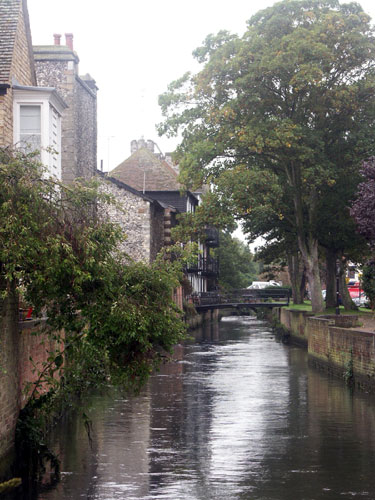
The River Stour
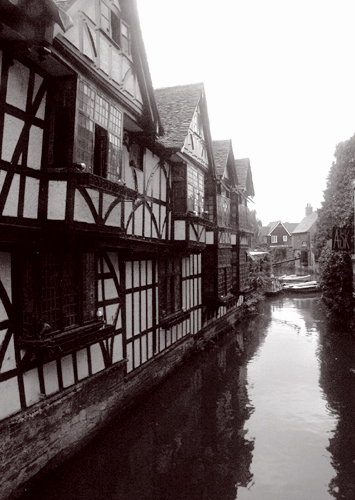
My recent photograph of the Weavers and of the River Stour
Picture of the tours landing stage c.1950s
The above photo courtesy of www.canterburyrivertours.co.uk
1515. An Act of Parliament passes for cleaning and deepening the river. A dyker is paid for making a dam, and turning the stream, at the end of the town-wall, by St. Mildred's church, for making of the King's mills. HT
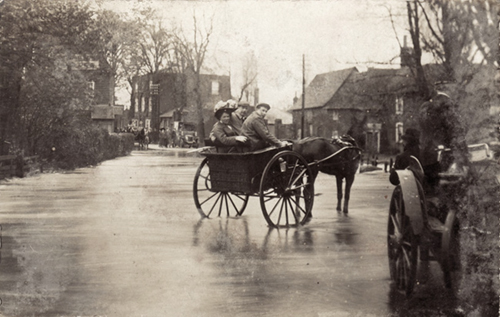
I originally thought that this card was Military Road - the sign on the left reads "...opards Head," which is likely "Leopards Head"
I'm very grateful to the
CURTIS family for supplying this photo postcard for the site
It turns out this photograph is of Sturry, Kent, thank you to David for this information and the write-up below:
"This Leopard's Head,
however, is not the one in Canterbury, but was to be found 3 miles out
of city at the village of Sturry. The flooding depicted took place in
November 1909, and was the worst in Sturry and Canterbury for 90 years,
following four inches of rain over a three-day period. The scene is
taken with Canterbury behind the photographer, facing north-east, standing
on the main road between the two places, where it curved over the river
Stour bypassing the Black Mill (out of shot to the right). Post-World
War Two, the mill having been demolished, the alignment of the main
road was straightened with a new bridge, but both old and new bridges
still stand side by side to this day, the former used as parking by
a car showroom!
The buildings in the picture still stand today; from left to right,
the Leopard's Head (now a private residence), Bridge House, and a sprawling
complex called either Old Mill House, Black Mill House, or similar (I
must have a look next time I go past!) Just out of shot in the distance,
Bridge House stands by a second, hump-backed, bridge that carries the
main road over a mill pond serving the White Mill, standing in the trees
to the left. This mill was also demolished in 1940, apparently to remove
a tempting landmark for the Luftwaffe (but did not stop the village
being wrecked by two bombs in 1941).
The horse and cart in the picture were provided by the County Council
to convey passengers over the worst part, and must have been quite fast
flowing water, as the paper reported that a lady cyclist was washed
off her bike, and was rescued by some men before ending up in the river!
The Leopard's Head was a Rigden's establishment, and remained a pub
until the 1930s, when it became tea rooms. In 1954, Frank Neaves, Motor
Engineer, used it until 1973, when it became the Viking Garage. A much
larger garage and showroom was built next door, and is a Mercedes-Benz
business today, using the aforementioned old bridge as parking."

Flooding of the River Stour, October 1909, at the Causeway which connects Pound Lane with North Lane. The Tower Inn was located at number 14 Pound Lane in 1903 and was run by Edwin Dalby. It closed for business as an Inn prior to World War 1.
I'm very grateful to the CURTIS family for supplying this photo postcard for the site
Flooding of the River Stour, October 1909, at the Causeway with the Cathedral in the background - from my collection
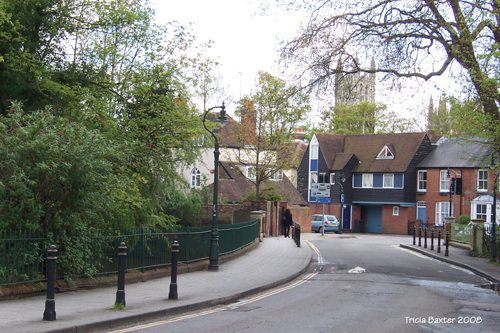
The Causeway Now
1596. The Corporation expend nearly 1400l. on the river. Hasted
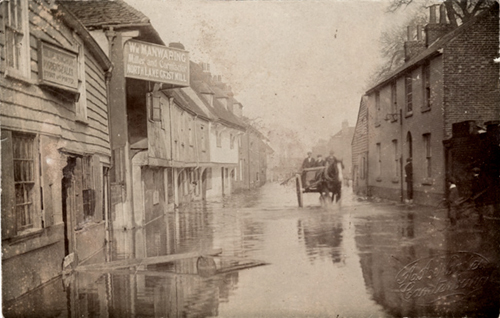
1909 North Lane, Flooding of the River Stour showing - Wm. Manwaring Miller and Cornfactor North Lane Grist Mill on the left
I'm very grateful to the CURTIS family for supplying this photo postcard for the site
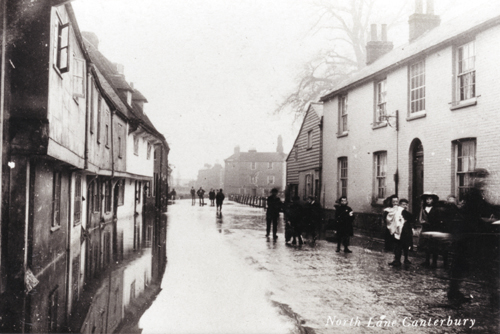
1909 North Lane, Flooding of the River Stour
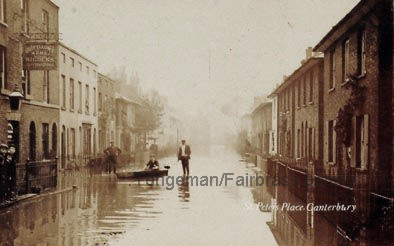
St. Peter's Place, A photo of the flooding October 1909, credit for this photo goes to the 'Tongeman/ Fairbrass' family
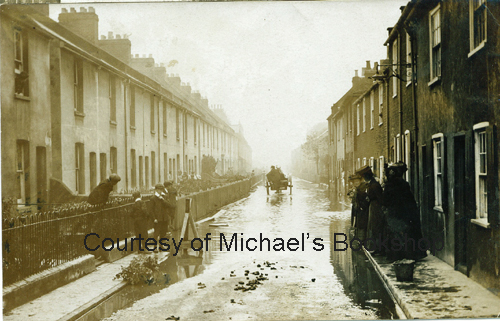
Black Griffin Lane, A photo of the flooding October 1909, the photo courtesy of michaelsbookshop.com
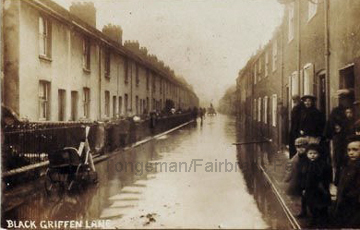
Black Griffin Lane, A photo of the flooding October 1909, credit for this photo goes to the 'Tongeman/ Fairbrass' family
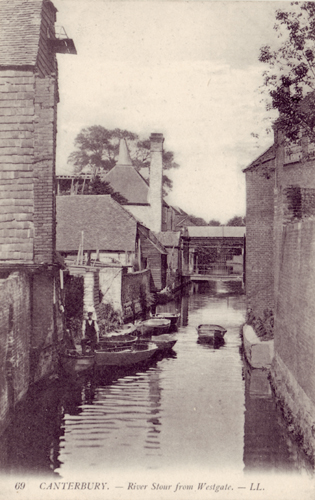 __
__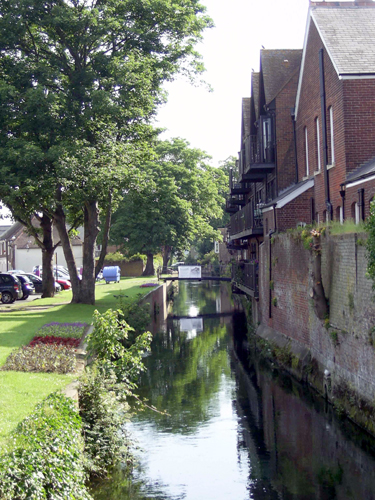
River Stour from Westgate, showing the backs of properties on the right from Pound lane, and the left from North lane & the NOW photo, courtesy of Len Parrick
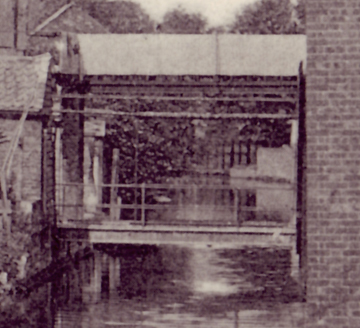
1638. The mayor and commonalty grant to Arnold Spencer all the powers, privileges and authorities, vested in them by act 6 Henry VIII. for deepening and cleaning the river. A wharf is directed to be made by the side of the river. (Hasted)
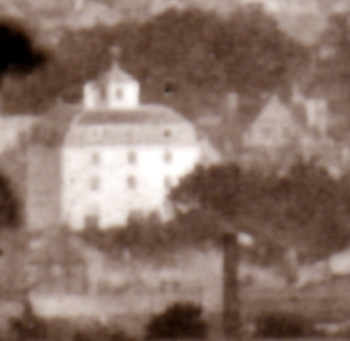
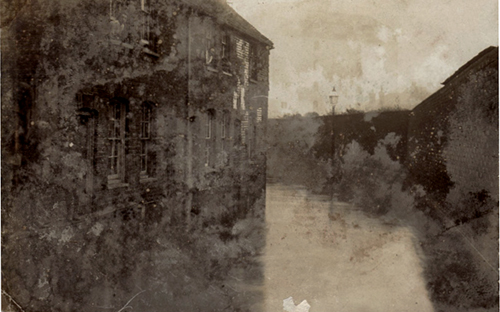
1909 Flooding of the River Stour showing St. Peter's Lane with the Abbot's Mill in the background. The Mill burnt down October 17th, 1933. The houses are gone, only the wall still stands.
I'm very grateful to the CURTIS family for supplying this photo postcard for the site

St. Peter's Lane Now, with new houses on the left
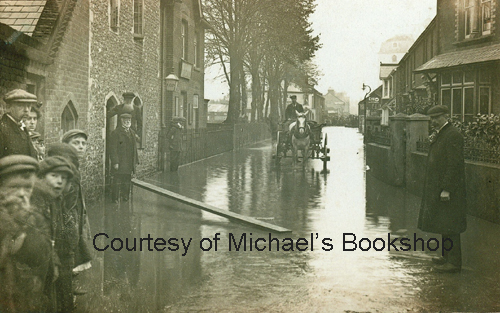
A photo of the flooding in Pound Lane, October 1909, the photo courtesy of michaelsbookshop.com
1695. The mayor and commonalty grant a lease, for 41 years, to Thomas Rogers, gent. of all their powers, privileges and authorities, vested in them by act 6 Henry VIII. to enable him to make the river Stour navigable, from Fordwich to Barton, or Browning's Mill. Hasted
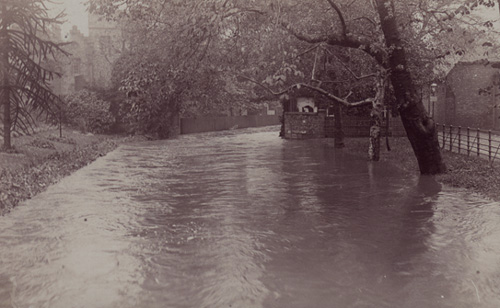
The Flood of 1909. On the Stour showing Tower House in the background on the left (see detail of Tower House below), the Tower House belonged to the Williamson family who donated it to the city.

...and Fordwich Trouts, near Canterbury, are incredibly large. - Magnae Britanniae Notitia 1718

Flooding in Black Griffin Lane Dec 1927, a photo from my collection (Noakes & Co.)
At Canterbury, the heavy rains which fell during the latter part of the last week have inundated the vale of the Stour, both above and below that city, and the water has risen in its vicinity to the ground floors of many of the houses adjoining the banks in Northlane, St. Peter's Lane, &c. Below Canterbury the valley to Starr had the appearance of a lake, and the adjacent levels of St. Nicholas, Minster, and Monkton, were so completely inundated as to give the idea of an estuary, and reduce Thanet literally to an island. The waters have since subsided. - The Gentlemen's Magazine, July to December 1810 *Nov

"The Water Joke"
The Stour Flooded..29th & 30th Oct. 1909 This is showing St. John's Board School now Kingsmead Primary School (the building on the left) and the Cathedral in the background with scaffolding
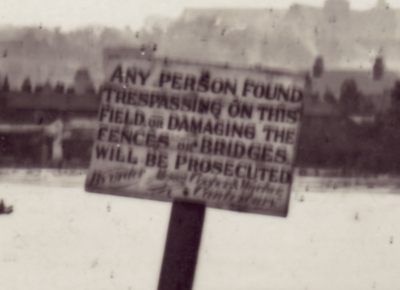
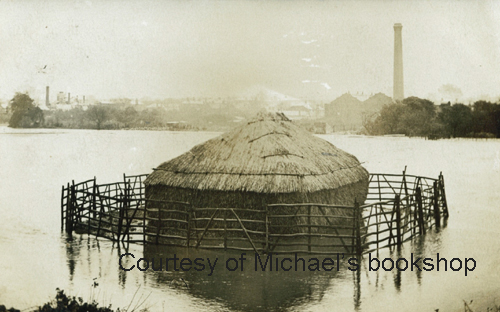
A photo of the flooding in Canterbury in October 1909, the photo courtesy of michaelsbookshop.com
"The Stour. The name which the river now bears was given it by the Saxons, who called at least three streams by that name one in Worcestershire; a second in Cambridge, Suffolk, and Essex; and a third, the present. The name means stirring, or moving. It supplanted the old British one of Durwhern, meaning swift river, whence the city derived its ancient Roman name of Durovernia, or Dorobernia. Since A.D. 686, the name Stour has existed. "It arises at Kingsnorth, near Ashford; takes its course by Wye and Chatham; divides itself at Canterbury into two streams; one of which passes through the city at King's-bridge, and the other by the bridge at Westgate, and uniting again below Barton mill, flows on, by Fordwich and the general valleys, to Sandwich Haven, and thence to the sea.
In 1594, it was proved in a law-suit that the river was navigable to Fordwich for barges of twelve tons, and about 1700, even to Sandwich; but at the present time, owing to the mills, &c., scarcely anything but a boat can pass on it. Various kinds of fish, but especially trout which would rejoice an Isaak Walton, are caught in it, and are of such value, that the right of fishing is leased out. The river drains in its course the hills on either side, and in ancient times often flooded the city."
Felix Summerly's handbook for the city of Canterbury 1843
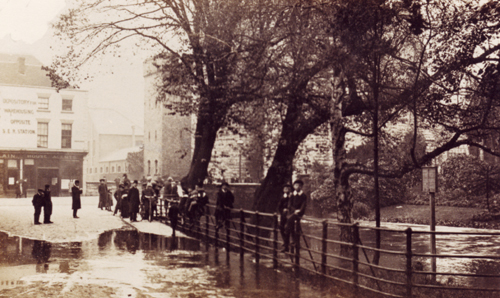
1909 Westgate Grove flooding, a postcard from my collection
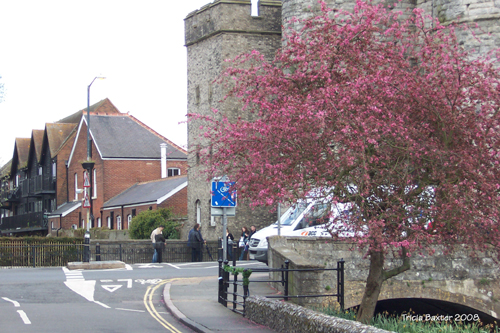
Westgate Grove Now
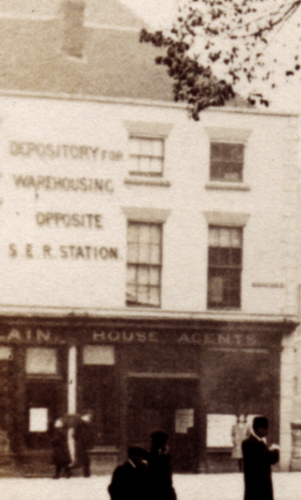 _
_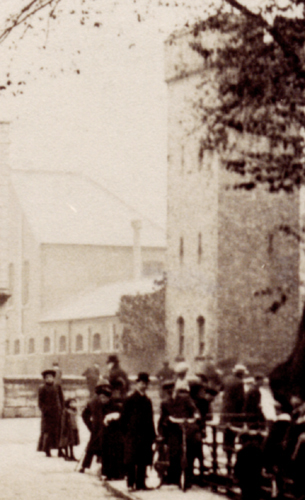
1909 Westgate Grove flooding, details from a postcard from my collection
![]()
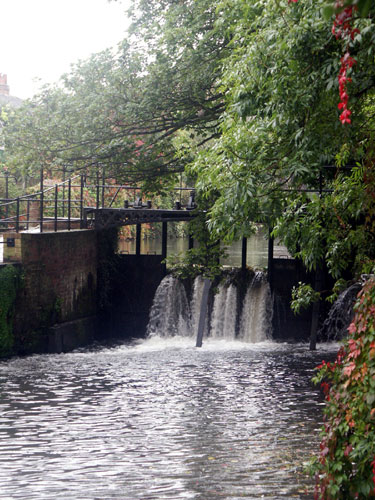 ____
____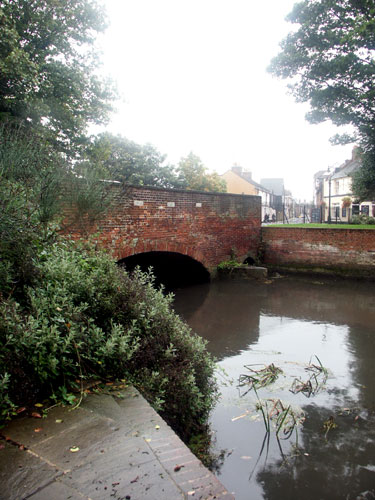
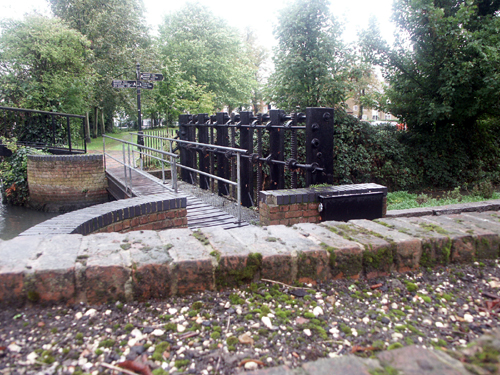
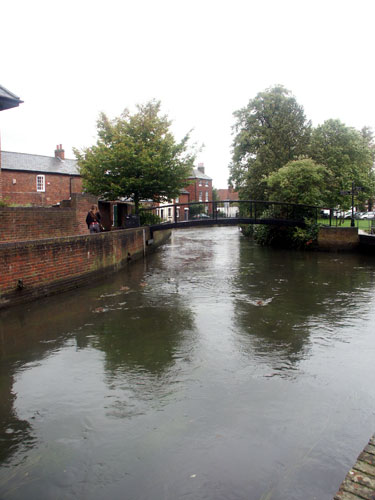 ____
____
My recent photographs of the River Stour
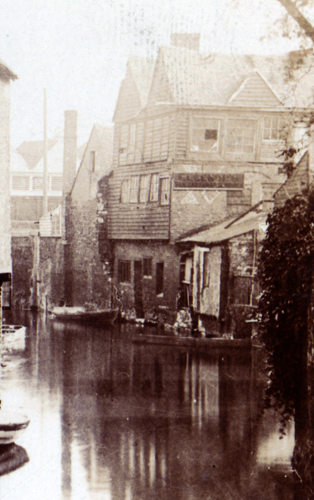
An old view down the River Stour near the Weavers
![]()
1889 Citizen's Fishery Association
Under the management of a Committee composed of the following gentlemen:
Capt. G. Austen J.P.
Capt. Lambert
Capt. Sadliler
George Hy. Delasaux (wine & spirits merchant)
Arthur H. Claris (proprietor of the Kent Herald)
A. J. Beer
F.C. Nash
This association is formed for the preservation of the fish in the River Stour, within the City boundaries, and on certain lands without the City. All citizens and visitors are allowed to fish free. A keeper is employed and paid by voluntary subscriptions and which are respectfully solicited by the Hon. Secretary, George Hy. Delasaux, High Street, to whom subscriptions may be paid.
1903
Charles Williamson, honorary secretary of the Stour Fishery Association, Ethelbert Road